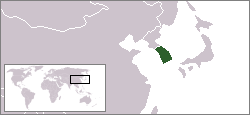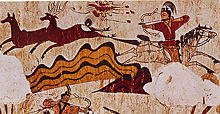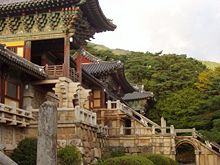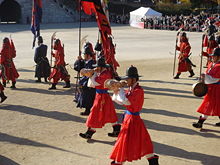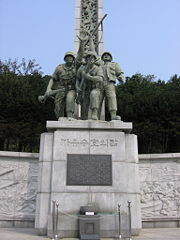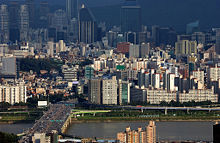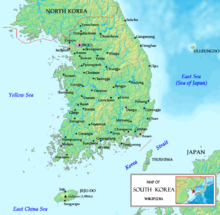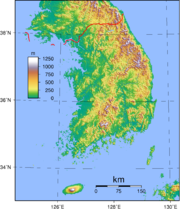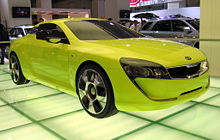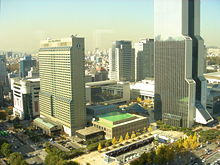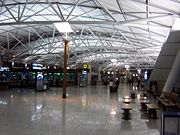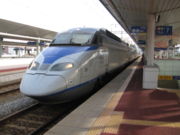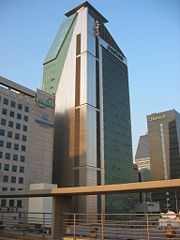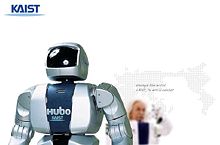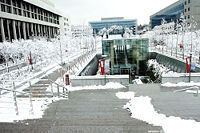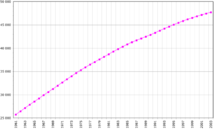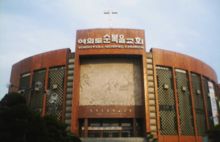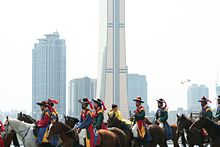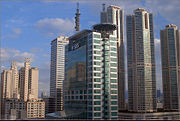South Korea
2008/9 Schools Wikipedia Selection. Related subjects: Asia; Asian Countries
| 대한민국 大韓民國 Daehan Minguk Republic of Korea
|
||||||
|---|---|---|---|---|---|---|
|
||||||
| Motto: 홍익인간(弘益人間) 널리 인간을 이롭게 하라 ("Benefit all mankind") | ||||||
| Anthem: Aegukga (애국가; 愛國歌) Patriotic Hymn |
||||||
|
|
||||||
| Capital (and largest city) |
Seoul |
|||||
| Official languages | Korean | |||||
| Demonym | South Korean, Korean | |||||
| Government | Presidential republic | |||||
| - | President | Roh Moo-hyun | ||||
| - | President-elect | Lee Myung-bak [Assuming office on February 25, 2008] |
||||
| - | Prime Minister | Han Duck-soo | ||||
| Establishment | ||||||
| - | Liberation declared | March 1, 1919 ( de jure) | ||||
| - | Liberation | August 15, 1945 | ||||
| - | First Republic | August 15, 1948 | ||||
| - | United Nations Recognition | December 12, 1948 | ||||
| Area | ||||||
| - | Total | 99,646 km² ( 108th) 38,492 sq mi |
||||
| - | Water (%) | 0.3 | ||||
| Population | ||||||
| - | 2007 estimate | 49,024,737 ( 24th) | ||||
| - | Density | 480/km² ( 19th) 1,274/sq mi |
||||
| GDP ( PPP) | 2007 estimate | |||||
| - | Total | $1.206 trillion ( 12th) | ||||
| - | Per capita | $25 000+ (2007) ( 31st) | ||||
| HDI (2007) | ▲ 0.921 (high) ( 26th) | |||||
| Currency | Won ( KRW) |
|||||
| Time zone | Korea Standard Time ( UTC+9) | |||||
| - | Summer ( DST) | not observed ( UTC+9) | ||||
| Internet TLD | .kr | |||||
| Calling code | +82 | |||||
| 1 | Mobile phone system CDMA, HSPDA & WiBro | |||||
| 2 | Domestic power supply 220V/60 Hz, CEE 7/7 sockets | |||||
South Korea, officially known as the Republic of Korea (ROK; Korean: 대한민국, IPA: [tɛː.han.min.ɡuk̚]), listen ) is an East Asian country occupying the southern half of the Korean Peninsula. To the north, it is bordered by North Korea (Democratic People's Republic of Korea), with which it was united until 1945. To the west, across the Yellow Sea, lies China and to the southeast, across the Korea Strait, lies Japan.
The Korean people trace their nation's founding back to 2333 BCE by the legendary Dangun Wanggeom. Archaeological research shows that the first Korean settlers have occupied the peninsula since the Lower Paleolithic period with territories expanding as far as mainland China and eastern Russia during the Gojosun period, the first nation established by Koreans. Korea's history has been turbulent at times with the last emperor of Korea dating back to the age of the Korean Empire. Since the establishment of the modern republic in 1948, South Korea has struggled with the aftermath of the Japanese control (1910-1945), the Korean War (1950-1953), and decades of authoritarian governments, undergoing five major constitutional changes. While the government officially embraced Western-style democracy from its founding, it was not until the December of 1987 that direct and fair elections were held and true democracy began to solidify.
South Korea has had one of the fastest growing economies in the world since the 1960s and is now the 3rd largest economy in Asia and the 11th largest economy in the world. In the late 20th century, many people referred to South Korea as a newly industrialized country and an Asian Tiger due to its exponential economic growth. Today, South Korea forms the G20 industrial nations and is a Next Eleven nation with many developing countries referring to its economic success as the " Miracle on the Han River," using South Korea's success story as a role model. South Korea has a "High" HDI of 0.912 and is part of both the CIA and IMF lists of advanced economies, being defined as a High Income Nation by the World Bank. International recognition of the country and its goods & services was boosted by the hosting of the 1988 Summer Olympics in Seoul and further enhanced by the co-hosting of the 2002 FIFA World Cup.
South Korea is one of the world's most technologically and scientifically advanced countries; it is the only country in the world with nationwide 100Mbit/s broadband internet access, full HDTV broadcasting, DMB, WiBro and 3G HSDPA. It is currently the most wired nation in the world, with more than 90 per cent of all homes connected to high speed broadband internet. South Korea is a global leader in electronics, computers, digital displays, semiconductor devices, mobile phones and hightech gadgets, headed by the two chaebols, Samsung and LG. South Korea also boasts the world's 3rd largest steel producer, POSCO and is the 5th largest automobile manufacturing nation, headed by Hyundai Kia Automotive Group. South Korea is the world's largest shipbuilder, lead by several multinational corporations such as Hyundai Heavy Industries and Samsung Heavy Industries. Other important industries of South Korea include robotics and biotechnology, with the world's second humanoid robot, EveR-1 and the world's first cloned dog, Snuppy.
Government
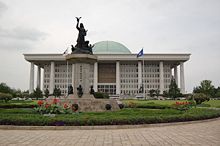
The government of South Korea is divided into three branches: executive, judicial, and legislative. The executive and legislative branches operate primarily at the national level, although various ministries in the executive branch also carry out local functions. Local governments are semi-autonomous, and contain executive and legislative bodies of their own. The judicial branch operates at both the national and local levels.
The South Korean government's structure is determined by the Constitution of the Republic of Korea. This document has been revised several times since its first promulgation in 1948 (see History of South Korea). However, it has retained many broad characteristics; with the exception of the short-lived Second Republic of South Korea, the country has always had a presidential system with a relatively independent chief executive.
As with most stable three-branch systems, a careful system of checks and balances is in place.
History
Before division
Archeological findings indicate that the Korean peninsula was occupied by humans as early in the Lower Paleolithic period.
Korea began with the legendary founding of Gojoseon in 2333 BCE by Dangun. Gojoseon expanded until it controlled much of the northern Korean peninsula and parts of Manchuria. After numerous wars with the Chinese Han Dynasty, Gojoseon disintegrated, leading to the Proto-Three Kingdoms of Korea period.
In the early centuries of the Common Era, Buyeo, Okjeo, Dongye, and the Samhan confederacy occupied the peninsula and southern Manchuria. Of the various small states, Goguryeo, Baekje, and Silla grew to control the peninsula as rival kingdoms.
The Buddhism and other influences from China had profound effects on Korea, which later passed on these, as well as their own advances, to Japan.
The unification of the Three Kingdoms by Silla in 676 CE led to the North-South States period, in which the much of the Korean peninsula was controlled by Unified Silla, while Balhae succeeded northern parts of Goguryeo. In Unified Silla, poetry and art was encouraged, and Buddhist culture flowered. Relationships between Korea and China remained good during this time. Unified Silla weakened under internal strife, and surrendered to Goryeo in 935. Balhae, Silla's neighbour to the north, was formed as a successor state to Goguryeo. During its height, Balhae controlled most of Manchuria and parts of Russia. It fell to the Khitan in 926 CE.
After the North-South Period, successor states fought for control during the Later Three Kingdoms period. The peninsula was soon united by Wang Geon of Goryeo. Like Silla, Goryeo was a highly cultural state and it created the Jikji in 1377, using the world's oldest movable metal printing press.
The Mongol invasions in the 13th century greatly weakened Goryeo. However, Goryeo continued to rule the Korean peninsula as a tributary ally to the Mongols. After the fall of the Mognolian Empire (by this time the Yuan Dynasty), Goryeo continued its rule. After severe political strife and continued invasions, Goryeo was soon replaced by the Joseon Dynasty in 1388 CE following a rebellion by General Yi Seong-gye.
General Yi named his country Joseon (reference to Gojoseon) and moved the capital to Seoul. The first 200 years of the Joseon Dynasty were very peaceful and saw the creation of hangul by King Sejong the Great in the 14 century CE and the rise and influence of Confucianism.
In the latter of the 16th century CE, Joseon was invaded by a newly unfied Japan. During the Japanese invasions of Korea (1592-1598), centuries of peace had left the dynasty unprepared, and the lack of technology and poor leadership from the government and generals led to the destruction of much of the Korean peninsula. However, continued Korean dominance at sea led by Admiral Yi, the rise of local militias, and intervention of Ming China put Japan under great pressure, which soon retreated in 1598 CE.
Today, Admiral Yi is celebrated as one of Korea's foremost heroes and his turtle ships, used with great success against the Japanese, are considered the world's first ironclad warships, although lack of hard evidence of iron plating sparks much debate.
During the last years of the Joseon Dynasty, Korea's isolationist policy earned it the name the " Hermit Kingdom," primarily for protection against Western imperialism. In 1910 CE, Korea was annexed by Japan and despite widespread resistance, remained under occupation until the end of World War II in 1945 CE.
After division
In the aftermath of World War II, Soviet Union and United States troops controlled the northern and southern halves of the country respectively. The two Cold War rivals established governments sympathetic to their own ideologies, leading to Korea's division into two political entities: North Korea and South Korea.
Despite the initial plan of a unified Korea in the 1943 Cairo Declaration, escalating Cold War antagonism eventually led to the establishment of two separate governments: the communist North and the capitalist South. In the North, a former anti-Japanese guerilla and communist activist, Kim Il Sung and in the South, freshly shipped from America, Syngman Rhee were installed as presidents. While North Koreans and South Koreans wanted a fully national election to choose a leader for the whole country, the division along Cold War faultlines prevented such an election.
On June 25, 1950, North Korea invaded the South leading to the Korean War. The Soviet boycott of the United Nations at the time, and therefore, no veto, allowed the UN to intervene when it became apparent that the superior communist forces would easily take over the entire country. The Soviet Union and China backed North Korea, with the participation of millions of Chinese troops. After huge advances on both sides, the war eventually reached a stalemate. The 1953 armistice, never signed by South Korea, split the peninsula along the demilitarized zone near the original demarcation line. No peace treaty was ever signed and the two countries are still technically at war.
In 1960, a student uprising led to the resignation of the autocratic and corrupt President Syngman Rhee. A period of profound civil unrest and general political instability followed, broken by General Park Chung-hee's military coup (the "5.16 coup d'etat") against the weak and ineffectual government the next year. Park took over as president until his assassination in 1979, overseeing rapid export-led economic growth as well as severe political repression. Park is heavily criticized as a ruthless military dictator, although the Korean economy developed significantly during his tenure.
The years after Park's assassination were marked by, again, considerable political turmoil as the previously repressed opposition leaders all campaigned to run for president in the sudden political void. In 1980, there was a coup d'etat, by General Chun Doo-hwan against the transitional government of Choi Gyu Ha, the interim president and a former prime minister under Park. Chun assumed the presidency. His seizure of power triggered nationwide protest demanding democracy, in particular the city of Gwangju, in South Cholla province where Chun sent in special forces to violently suppress the city, in what is now known as the Gwangju Massacre. Until 1987, he and his government held Korea under despotic rule when Park Jong Chul - a student attending Seoul National University - was tortured to death. The Catholic Priests' Association for Justice revealed that Park was tortured, igniting huge demonstrations around the country. The demonstrations snowballed when another student from Yonsei University, Lee Han Yeol, was killed by a police-fired tear gas bomb while he was demonstrating against the military government. The period of resistance is called the Resistance of June when all joined the national movment. Eventually, Chun's party, the Democratic Justice Party, and its leader, Roh Tae Woo announced the 6.29 Declaration, which included the direct election of the president.
In 1988, Seoul hosted the 1988 Summer Olympics, cause of national celebrations in contrast to great turmoil of the past. In 1996, South Korea became a member of the Organization for Economic Co-operation and Development and in 1997, suffered the Asian financial crisis but after swift recovery , the country was able to re-emerge and continue its growth towards a major economic power.
In June 2000, as part of South Korean president Kim Dae Jung's Sunshine Policy of engagement, a North-South summit took place in North Korea's capital Pyongyang. That year, Kim received the Nobel Peace Prize "for his work for democracy and human rights in South Korea and in East Asia in general, and for peace and reconciliation with North Korea in particular"
In 2004, South Korea joined the "trillion dollar club" of world economies.
Foreign relations
In its foreign relations, South Korea is primarily concerned with North Korea and the neighboring countries of China, Japan, and Russia, as well as its main ally, the United States.
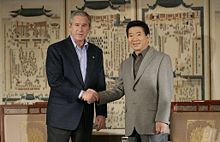
United States
The United States of America was the primary driver in the establishment and initial sustainment of the South Korean government before and after the Korean War. Since the 1990s, the two nations have often been at odds with regard to their policies towards North Korea, and over the rise of anti-American sentiment often expressed toward members of the U.S. military,sometimes violently. Nevertheless, most South Koreans are friendly towards the United States. Korea concluded a Free Trade Agreement agreement with the United States in April 2007.
China
Korea usually had close relations with the Chinese since historic times. Korean independence fighters also worked with Chinese soldiers during the period of Japanese occupation. However, after World War II, the Chinese embraced communism while South Korea became a republic with the help of the United Nations. The Korean War and its aftermath made the relationship between South Korea and China almost nonexistent. However, South Korea and China established formal diplomatic relations on August 24, 1992. The two countries sought to improve the economy and lifted the trade embargo. Korean and Chinese relations have expanded steadily since 1992.
Japan
South Korea and Japan signed the Treaty on Basic Relations between Japan and the Republic of Korea in 1965. However South Korea has heavy Anti-Japanese sentiment due to a number of unsettled Korean-Japanese disputes, many of which stemmed from the period of Japanese occupation. During World War II, more than 100,000 Koreans were forced to serve in the Imperial Japanese Army. Longstanding issues such as Korea under Japanese rule against Korean civilians, the visits by Japanese politicians to the Yasukuni Shrine honoring Japanese soldiers killed at war, including class A war criminals like Hideki Tojo, the re-writing of Japanese textbooks to overlook Japanese aggression during World War II, and the territorial disputes over Liancourt Rocks continue to trouble Korean-Japanese relations. In response to then- Prime Minister Jun'ichiro Koizumi's repeated visits to the Yasukuni shrine, the President of South Korea Roh Moo-hyun suspended all summit talks between South Korea and Japan. At present, South Korea and Japan's political relations are unstable but thawing progressively.
North Korea
Both North and South Korea continue to officially claim sovereignty over the entire peninsula. With longstanding animosity following the Korean War from 1950-1953, North Korea and South Korea signed an agreement to pursue peace on October 4, 2007.
On October 4th, 2007, Roh Moo-Hyun and North Korean leader Kim Jong Il signed an 8-point peace agreement on issues of permanent peace, high-level talks, economic cooperation, renewal of train, highway and air travel, and a joint Olympic cheering squad.
Despite the Sunshine Policy and efforts at reconciliation, the progress was complicated by North Korean missile tests in 1993, 1998, and another in 2006.
Other nations
South Korea maintains diplomatic relations with approximately 170 countries. The country has also been a member of the United Nations since 1991, when it joined at the same time as North Korea. On January 1, 2007, South Korean Foreign Minister Ban Ki-moon assumed the post of UN Secretary-General. It has also developed links with Association of Southeast Asian Nations as both a member of "ASEAN Plus three" and the East Asia Summit (EAS).
South Korea started negotiations with the European Union about Free Trade Agreement, which is the second largest importer of Korean goods. The negotiations are ongoing.
Military
The South Korean military is composed of the Republic of Korea Army (ROKA), Republic of Korea Navy (ROKN), Republic of Korea Air Force (ROKAF), and Republic of Korea Marine Corps (ROKMC) together with reserve forces . Many of these forces are concentrated near the border with North Korea, near and around the demilitarized zone. All South Korean males are constitutionally required to serve in the military, typically for a period of two years. However, there has been debates about shortening the length of the military services, and even dismissing the requirement itself. The government recently allowed some male students who earned university bachelor's degree to dismiss the military requirements to let them to further study and research on their fields.
From time to time, South Korea has sent its troops overseas to assist American forces. It has participated in every major conflict the United States has been involved in the past 50 years. South Korea dispatched 320,000 troops to fight alongside American and South Vietnamese soldiers in the Vietnam War, with a peak strength of 50,000. Most recently, South Korea sent 3,300 troops in the form of the Zaytun Division to help re-building in northern Iraq, and is the largest contributor after the U.S. and Britain.
The United States has stationed a substantial contingent of troops in the ROK since the Korean War to defend South Korea in case of an attack from North Korea. There are also approximately 29,000 US soldiers stationed in Korea, most of them serving one year unaccompanied tours. The American Troops are stationed in bases, of which most are camps. They are considered camps not for their lack of buildings or support structure but in order to represent a lack of permanence for the ROK Government.
A still functioning UN Command controls all forces in South Korea, including the US forces and the entire Korean military.
(See List of United States Army installations in South Korea and USFK for more information on these military bases.)
Currently, its navy is working towards a blue-water navy. It has recently equipped its King Sejong the Great class destroyer with the Aegis Combat System. South Korea is the fifth country operating the Aegis Combat System .
Administrative divisions
| Namea | Hangul | Hanja | |||||||||||||||||||||||||||||
|---|---|---|---|---|---|---|---|---|---|---|---|---|---|---|---|---|---|---|---|---|---|---|---|---|---|---|---|---|---|---|---|
| Special cities (Teukbyeolsi a) | |||||||||||||||||||||||||||||||
| 1 | Seoul (National Capital) | 서울특별시 | 서울特別市 | ||||||||||||||||||||||||||||
| Metropolitan cities (Gwangyeoksi a) | |||||||||||||||||||||||||||||||
| 2 | Busan | 부산광역시 | 釜山廣域市 | ||||||||||||||||||||||||||||
| 3 | Daegu | 대구광역시 | 大邱廣域市 | ||||||||||||||||||||||||||||
| 4 | Incheon | 인천광역시 | 仁川廣域市 | ||||||||||||||||||||||||||||
| 5 | Gwangju | 광주광역시 | 光州廣域市 | ||||||||||||||||||||||||||||
| 6 | Daejeon | 대전광역시 | 大田廣域市 | ||||||||||||||||||||||||||||
| 7 | Ulsan | 울산광역시 | 蔚山廣域市 | ||||||||||||||||||||||||||||
| Provinces | |||||||||||||||||||||||||||||||
| 8 | Gyeonggi-do | 경기도 | 京畿道 | ||||||||||||||||||||||||||||
| 9 | Gangwon-do | 강원도 | 江原道 | ||||||||||||||||||||||||||||
| 10 | Chungcheongbuk-do | 충청북도 | 忠淸北道 | ||||||||||||||||||||||||||||
| 11 | Chungcheongnam-do | 충청남도 | 忠淸南道 | ||||||||||||||||||||||||||||
| 12 | Jeollabuk-do | 전라북도 | 全羅北道 | ||||||||||||||||||||||||||||
| 13 | Jeollanam-do | 전라남도 | 全羅南道 | ||||||||||||||||||||||||||||
| 14 | Gyeongsangbuk-do | 경상북도 | 慶尙北道 | ||||||||||||||||||||||||||||
| 15 | Gyeongsangnam-do | 경상남도 | 慶尙南道 | ||||||||||||||||||||||||||||
| Special self-governing province (Teukbyeoljachi-do a) | |||||||||||||||||||||||||||||||
| 16 | Jeju | 제주특별자치도 | 濟州特別自治道 | ||||||||||||||||||||||||||||
a Revised Romanization.
b.
Geography and climate
South Korea occupies the southern portion of the Korean Peninsula, which extends some 680 miles (1,100 km) from the Asian mainland. This mountainous peninsula is flanked by the Yellow Sea to the west, and the Sea of Japan (East Sea) to the east. Its southern tip lies on the Korea Strait and the East China Sea. The country's total area is 38,462.49 square miles (99,617.39 km²).;
South Korea can be divided into four general regions: an eastern region of high mountain ranges and narrow coastal plains; a western region of broad coastal plains, river basins, and rolling hills; a southwestern region of mountains and valleys; and a southeastern region dominated by the broad basin of the Nakdong River.
South Korea's land is mountainous, and most of it is not arable. Lowlands, located primarily in the west and southeast, constitute only 30% of the total land area.
About three thousand islands, mostly small and uninhabited, lie off the western and southern coasts of South Korea. Jeju Island is located about 100 kilometers (about 60 mi) off the southern coast of South Korea. It is the country's largest island, with an area of 1,845 square kilometers (712 sq mi). Jeju is also the site of South Korea's highest point: Halla-san, an extinct volcano, reaches 1,950 meters (6,398 ft) above sea level. Other islands of South Korea include Ulleungdo and Dokdo, which is South Korea's farthest claimed territory to the east and Marado, which is the ROK's southernmost point. However, Dokdo is one of many disputes with Japan. Ulleungdo is inhabited.
Climate
| Climate chart for South Korea | |||||||||||
|---|---|---|---|---|---|---|---|---|---|---|---|
| J | F | M | A | M | J | J | A | S | O | N | D |
|
23
1
-7
|
25
3
-5
|
47
10
0
|
94
17
7
|
92
23
13
|
134
26
17
|
369
29
22
|
294
30
22
|
169
26
17
|
50
20
10
|
53
11
3
|
21
4
-4
|
| temperatures in °C • precipitation totals in mm source: http://www.climate-charts.com/Locations/k/KO47108.html |
|||||||||||
|
Imperial conversion
|
|||||||||||
The local climate is relatively temperate, with precipitation heavier in summer during a short rainy season called jangma, and winters that can be bitterly cold. In Seoul, the average January temperature range is -7 ° C to 1 °C (19 ° F to 33 °F), and the average July temperature range is 22 °C to 29 °C (71 °F to 83 °F). Winter temperatures are higher along the southern coast and considerably lower in the mountainous interior. Rainfall is concentrated in the summer months of June through September. The southern coast is subject to late summer typhoons that bring strong winds and heavy rains. The average annual precipitation varies from 1,370 millimeters (54 inches) in Seoul to 1,470 millimeters (58 inches) in Busan. There are occasional typhoons that bring high winds and floods. The government is concerned of the impact of global warming on the natural disasters.
Environment
In urban areas there are problems associated with air pollution as well as water pollution from the discharge of sewage and industrial effluents. Cheonggyecheon is one of the examples of restoring the flow of the clean water in South Korea.
South Korean joined numerous environmental organizations: Antarctic-Environmental Protocol, Antarctic Treaty, Biodiversity, Climate Change, Desertification, Endangered Species, Environmental Modification, Hazardous Wastes, Law of the Sea, Marine Dumping, Nuclear Test Ban, Ozone Layer Protection, Ship Pollution ( MARPOL 73/78), Tropical Timber 83, Tropical Timber 94, Wetlands, and Whaling.
Economy
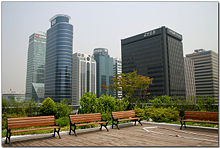
South Korea is a major international economic power; it has the eleventh largest economy in the world and the third largest in Asia, behind Japan and China. Its largest trading partner and export market today is China. South Korea has achieved rapid economic growth through exports of manufactured goods, and is one of the Four Asian Tigers. Major industries in South Korea today are automobiles, semiconductor, electronics, shipbuilding, and steel.
In the 1950s, South Korea was one of the poorest countries in Asia. This was partly due to the destruction of much of the country's infrastructure during the Korean War.
Following the military coup led by General Park Chung-hee in 1962, South Korea embarked on a series of ambitious five-year plans for economic development similar to the macro-economic schemes of the Soviet Union. Emphasis shifted to foreign trade with the normalization of relations with Japan in 1965, which resulted in a boom in trade and investment. Rapid expansion, first into light and then heavy industries, so in 1973 Korea became the 34th wealthiest country in the world. Park's government plans for economic development greatly boosted the Korean economy.
This growth is often called the " Miracle on the Han River", the Han River being the main river that runs through the nation's capital and largest city, Seoul. In the 1980s and 1990s, growth continued as South Korea transformed itself from an exporter of mostly textiles and shoes into a major global producer of automobiles, electronics, shipbuilding, steel and, later, high-technology products such as digital monitors, mobile phones, and semiconductors.
The South Korean model of encouraging the growth of large, internationally competitive companies through easy financing and tax incentives led to the dominance of the family-controlled conglomerates. These companies, known as chaebol, flourished under the support of the Park regime. Some such as Hyundai, Samsung, LG and SK Company became global corporations. In 2004, South Korea joined in the trillion dollar club of world economies.
Since the Asian financial crisis of 1997 the corporate landscape has changed considerably as a result of massive bankruptcies and government reforms. The crisis exposed longstanding weaknesses in South Korea's economy, including high debt-to-equity ratios, massive foreign borrowing, and an undisciplined financial sector. This led to two rounds of financial and industrial restructuring; once in 1997 and again following the collapse of Daewoo in 1999. Daewoo's collapse has been recorded as one of the largest bankruptcies in world history. By 2003, just over one-half of the 30 largest chaebol from 1995 remained.
Between 2003 and 2005, economic growth had slowed to about 4% per year. A downturn in consumer spending, attributed to massive personal credit card debt, was offset by rapid export growth, primarily to China. In 2005, the government proposed labor reform legislation and a corporate pension scheme to help make the labor market more flexible, and new real estate policies to cool property speculation. In 2006, South Korean economy has recovered its growth rate to 5.1%.
The South Korean economy is characterized by moderate inflation, low unemployment, an export surplus, and fairly equal distribution of income.
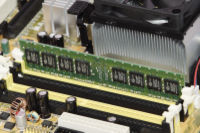
Today, there are several strong South Korean industries. South Korea's largest automaker, Hyundai Motor Company and its subsidiary Kia Motors are the 5th largest car group in the world. Korean carmakers are planning to increase their exports even more when Korea finishes its FTA with the European Union.
South Korea's shipbuilding industry is also the largest in the world. It became the largest after overtaking Japan in 2004. South Korean shipbuilding is efficient enough that a new $80 million vessel is produced every four working days. In 2006, approximately one in every three new vessels was constructed in Korea. Hyundai Heavy Industries built ships totaling 10.6 million compensated gross tons (CGTs), or 34.6 percent, becoming the first nation to breach the 10 million CGT mark. Other Korean shipbuilding companies are Samsung Heavy Industries and Daewoo Marine Engineering & Construction.
Although South Korean shipmakers are leading in terms of ship orders and production, they are wary of Chinese shipmakers. China is planning to become the world's leader in shipbuilding by 2015. However, South Korean shipbuilders have advantage over Chinese counterparts in terms of advanced value-added shipbuilding technology.
Transportation
Transportation in South Korea is provided by an extensive network of railways, highways, bus routes, ferry services, and air routes. Buses, taxis, subways, and trains provide comfortable and cheap methods of travel around South Korea. Major cities have subway systems, including the popular Seoul Subway. Korail commuter lines are already linked with Seoul's subway system and several commuter lines connected with Busan and Daegu subway systems are under construction. They have intercity and intracity bus systems. Metropolitan Cities have express bus terminals.
Highways in South Korea are classified into highways (expressways/motorways), national highways, and various classifications below the national level. Korea Highway Corporation operates the toll highways and service amenities en route. South Korea has about 3,000 kilometers of national highways.
Korail provides frequent train service to all major South Korean cities. Two rail lines, Gyeongui and Donghae Bukbu Line, to North Korea are now being reconnected. The Korean high-speed railway system, KTX, provides high-speed service along Gyeongbu and Honam Line. KTX had been built with France's technological cooperation, but government intentionally had made it non-public.
The main international airport is Incheon International Airport. South Korea has eight international airports and seven domestic airports. South Korea's major international air carriers are Korean Air and Asiana Airlines. About 71 international passenger and cargo airlines operate frequent flight services between Korea and all over the world.
Science and technology
South Korea is among the world's most technologically advanced and digitally-connected countries; it has the third most broadband Internet users among the OECD countries and is a global leader in electronics, digital displays, semiconductor devices, and mobile phones.
Modern Industries
South Korea also leads the world in the shipbuilding industry, headed by chaebols such as the Hyundai Heavy Industries, Samsung Heavy Industry and POSCO. South Korea also exports radioactive isotope production equipment for medical and industrial use to countries such as Russia, Japan, Turkey and others.
Space programs
Korea has a full-fledged space partnership with Russia and has launched the Arirang-1 and Arirang-2 which both have surveillance cameras equipped. Naro Space Centre, the first spaceport of the Republic of Korea, is scheduled to be completed by the end of 2007 or early 2008 at Goheung County, South Jeolla. Korea Space Centre is expected to send a Korea Space Launch Vehicle into space in 2008. The spaceport will be controlled by the state-run Korea Aerospace Research Institute and will contain features necessary for spaceflight operation having a launch tower, a control tower, rocket assembly, test facilities and space simulators.
Robotics
In robotics, Korea Advanced Institute of Science and Technology (KAIST) competes with the Japanese company Honda with its humanoid robot HUBO. Honda's ASIMO and KAIST's HUBO lines are the two of very few humanoid robots that can walk. The first HUBO was developed within a span of 3 years and cost 1 million USD.
Energy
In renewable energy, South Korean scientists at the Gwangju Institute of Science and Technology in cooperation with the University of California, Santa Barbara successfully developed an organic photovoltaic power cell with energy efficiency of 6.5 percent.
Education
Education in South Korea is regarded essential to success and competition is consequently very tense. A centralized administration in South Korea oversees the process for the education of children from kindergarten to third grade high school. Mathematics, science, Korean, social studies, and English are generally considered to be the most important subjects and are considered compulsory. South Korea was the first country in the world to provide high-speed internet access from every primary, junior, and high school. The Programme for International Student Assessment, coordinated by the OECD, currently ranks South Korea's education as the 11th best in the world, being significantly higher than the OECD average.
The school year is divided into two semesters. The first begins in the beginning of March and ends in mid-July; the second begins in late August and ends in mid-February. The schedules are not rigidly standardized, however, and can vary from school to school.
Demographics
Most South Koreans live in urban areas, due to rapid migration from the countryside during the country's rapid economic expansion in the 1970s, 1980s and 1990s. The capital city of Seoul is also the country's largest city and chief industrial centre. It had 10.3 million inhabitants in 2006, making Seoul one of the most populated single cities in the world. Other major cities include Busan (3.65 million), Incheon (2.63 million), Daegu (2.53 million), Daejeon (1.46 million), Gwangju (1.41 million) and Ulsan (1.10 million).
The population has also been shaped by international migration. Following the division of the Korean peninsula after World War II, about four million people from North Korea crossed the border to South Korea. This trend of net entry reversed over the next forty years due to emigration, especially to the United States and Canada. However, South Korea's burgeoning economy and democracy in the early and mid-1990s slowed the high emigration rates typical of the previous decades. The current population of South Korea is roughly 48,850,000.
Although small, the percentage of non-Koreans has been increasing. Officially, as of the summer of 2007, there are just over 1 million foreigners living in Korea. That number includes foreign residents, students, tourists and illegal aliens. Among them, 104,749 people were married to Koreans, 404,051 were working here and 225,273 were illegal aliens.
Korean farmers have a hard time finding a wife because of their location and occupation, few young women want this life style. Farmers are forced to look abroad to find their wife, most from the much poorer Southeast Asia. For the year 2006, 41% of the marriages amongst the farmers were to foreign nationals.
There are 31,000 U.S. military personnel.
As of 2005, approximately 22 million or 46.5% of the South Korean population express no religious preference. Of the remainder, 13.7 million are Christian (of which 8.6 million profess to be Protestants and 5.1 million to be Catholics), 10.7 million are Buddhist, and less than half a million belong to various minor religions including Jeungsando and Wonbuddhism. The largest Christian church in South Korea, Yoido Full Gospel Church, is located in Seoul and has approximately 780,000 members (2003 estimate). Including Yoido Full Gospel, 11 of the world's 12 largest churches are located in Seoul (see Korean Christianity). South Korea is also the second largest missionary sending nation on earth, after the U.S. Islam in Korea is estimated to be at 45,000 in addition to some 100,000 foreign workers from Muslim countries. Islam is also the fastest growing religion in country.
Culture
South Korea shares its traditional culture with North Korea, but the two Koreas have developed distinct contemporary forms of culture since the peninsula was divided in 1945. The South Korean Ministry of Culture and Tourism actively encourages the traditional arts, as well as modern forms, through funding and education programs.
Korean forms of metalwork, sculpture, painting, and ceramics flourished throughout the Korean peninsula. In modern times, Western and particularly the US influences have been strongest. In the aftermath of Japanese occupation all Japanese cultural exports were banned from Korea until 1999. However, trading between the two countries has grown, although there is still strong anti-Japanese sentiment in South Korea.
Recently, Korean pop culture has become popular in Asia and beyond, earning the name Hallyu or " Korean Wave." In Japan, Korean singers like BoA and television drama like Winter Sonata have found success. Recent Korean films such as Old boy and Oasis have also received international acclaim.
The contemporary culture of South Korea is heavily dominated by technology, including feature-rich cell phones and pervasive online games. South Korea today has the highest penetration of high-speed internet access to households in the world. In South Korea, computer games take on a sport-like presentation. The professional leagues are televised with announcers, professional players and major corporate sponsors.
South Korea retains centuries-old customs and traditions, such as its cuisine, ancestor worship, blood line and some Confucianism ideals. Foods like Steamed Rice(밥), Bulgogi (불고기, Korean style beef BBQ), Gimbap (김밥, rice roll wrapped in seaweed), Mandu (만두, dumplings), Doenjang jjigae (된장찌개, fermented soybean paste), Japchae (잡채, Boiled sweet potato starch noodles mixed with fried vegetables), Tteokbokki (떡볶이, a broiled dish made with sliced rice cake, seasoned beef, fish cakes and vegetables), Bibimbap (비빔밥, mixed rice with vegetables, beef, egg and chili pepper paste) and Kimchi (김치, fermented vegetables) are staples of the Korean diet.
Sports

Taekwondo, a popular martial art, originated in Korea. In the 1950's and 60's, modern rules were standardized, and Taekwondo became an official Olympic sport in 2000. Taekwondo in the military is an integral part in the Korean land forces. Other Korean martial arts include subak and taekkyeon.
Baseball was first introduced to Korea in 1905 and has since become the most popular spectator sport in South Korea. The first South Korean professional sports league was the Korea Baseball Association, established in 1982. During the 2006 World Baseball Classic, South Korea reached the semi-finals.
Other known sports in South Korea include basketball, football, golf, tennis and ice hockey. Women's golf is especially strong, with 45 South Koreans playing in the U.S. LPGA Tour, including Hall of Famer Se Ri Pak.
Starcraft is also a popular online game in South Korea. Its fanbase exceeds five million, and has two Korean-based channels dedicated to its broadcast. Professional Starcraft player Lim Yo-Hwan ( SlayerS_`BoxeR`) earned over USD $300,000 during the peak of his career and owns the record for the most DVD's sold in Korea, beating out the entire Matrix trilogy.
In 1988, South Korea hosted the Summer Olympics in Seoul for the first time. South Korea's Olympic teams have performed strongly in archery, shooting, table tennis, short track speed skating, handball, freestyle wrestling, judo, taekwondo, and football. South Korea has also hosted the Asian Games in 1986 and 2002. Recently, Pyeongchang County was a finalist for the 2014 Winter Olympics, but lost to Sochi, Russia.
The 2002 FIFA World Cup was jointly hosted by South Korea and Japan, and South Korea became the first Asian team to reach the semi-finals. The Korea Republic national football team, also known as the " Taeguk Warriors", played in the 2006 FIFA World Cup in Germany for their sixth consecutive World Cup.
In 2007, South Korea hosted a cycling competition called Tour de Korea. It was the first international cycling competition in South Korea in 10 years. In 2010 South Korea will host their first Formula 1 race to be staged at Korean International Circuit in Yeongam County about 240 miles (390 km) south of Seoul.
International rankings
| Organization | Title | Ranking |
|---|---|---|
| OECD | Annual work hours | 1 out of 27 |
| Economist Intelligence Unit | IT Industry Competitiveness Index (2007) | 3 out of 64 |
| OICA | Automobile Production | 5 out of 53 |
| UN Department of Economic and Social Affairs | UN E-Government Survey 2008 | 6 out of 192 |
| CIA World Factbook | Gross Domestic Product (PPP) | 11 out of 227 |
| World Economic Forum | Global Competiveness | 11 out of 131 |
| International Monetary Fund/ World Bank | Gross Domestic Product (nominal) | 12 out of 183 |
| World Bank | Ease of Doing Business | 15 out of 177 |
| United Nations Development Program | Human Development Index | 26 out of 177 |
| The Economist | Global Peace Rating | 29 out of 121 |
| Economist Intelligence Unit | Quality of Life | 30 out of 155 |
| Heritage Foundation/The Wall Street Journal | Index of Economic Freedom | 36 out of 157 |
| Reporters Without Borders | Worldwide press freedom index | 39 out of 169 |
| Transparency International | Corruption Perceptions Index | 42 out of 180 |
| Freedom House | Civil Liberties and Political Rights | Top tier country† |
†Complete Civil and Political freedom

